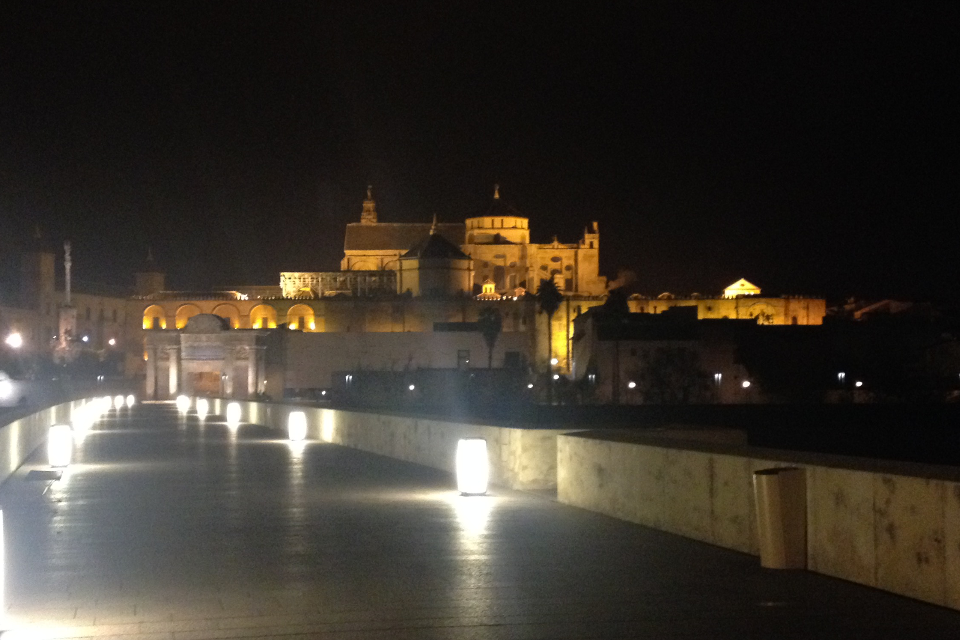Julio 2016 es el comienzo de mis próximo paso en la vida, trabajando en Madrid un año entero. Antes de echar un vistazo hacia el futuro, me gustaría transmitir unos mensajes sobre mis experiencias en Córdoba en este reportaje y en los reportajes futuros.
Una introducción a Córdoba:
En 1994 Córdoba fue declarado Patrimonio de la Humanidad por la Unesco. La cultura romana, árabe y cristiana se ve por toda la ciudad con puntos de referencia como el Puente Romano, la Judería y lo más famoso, la Mezquita. Durante el siglo diez Córdoba era la ciudad más poblada del mundo con un poder económico muy alto sin embargo, hoy en día tiene 300,000 habitantes y su industria principal es el turismo. A mí me encantó mi estancia allí, es una ciudad donde todo se encuentra muy cerca y si tenía una tarde libre era muy fácil dar un paseo por la ciudad para disfrutar todo lo que se ofrece.
Semana Santa:
Semana Santa sin duda fue la semana más espectacular de mi estancia en Córdoba y me dio un entendimiento verdadero sobre la significancia de la religión allí. Cada hermandad en la ciudad tiene su propia procesión durante la semana y empiezan en la parroquia de su pueblo. Los costaleros son las personas que llevan las estructuras religiosas (representan historias de la Biblia) y los siguen los nazarenos. Tuve mucha suerte ver una procesión en la Mezquita y fue muy especial, había todo el mundo allí en silencio mientras leyeron pasajes de la Biblia y cantaron himnos preciosos.
Gastronomía:
Para acostumbrarse completamente en un país, hay que probar toda la cocina local y la cocina de Córdoba está muy buena. El plato cordobés más famoso es el salmorejo y tiene tomate, ajo, jamón serrano, pan y como siempre en España, viene con mucho aceite de oliva. Aunque no es el plato más famoso, preferí el flamenquín que originó del pueblo Bujalance en la provincia de Córdoba. Es jamón serrano redondeado por cerdo con pan rallado y frito. Otros platos típicos incluyen el pastel cordobés, rabo de toro y naranjas picadas.
Datos interesantes de Córdoba:
• Manchester es su cuidad hermanada
• La ciudad más calurosa en Europa
• Hasta 1953 había solo una ruta a la ciudad (por el Puente Romano)
Aconsejo a todos que visitéis a Córdoba, una ciudad pequeña pero con una identidad especial. ¡Mi estancia allí fue increíble!
July 2016 marks the start of my next journey, working in Madrid for one year. Before looking forward to the future its important to reflect on what has happened over the past five months during my time in Córdoba and to share some of my experiences in this report and future ones.
Introduction to Córdoba
In 1994 Córdoba was declared a World Heritage Site by Unesco. It’s Roman, Moorish and Christian heritage is represented throughout the city’s iconic landmarks such as the Roman Bridge, the Jewish Quarter and the most famous of all, the Mezquita. During the 10th century Córdoba was the most populous city in the world with strong economic potential however nowadays it has just over 300,000 inhabitants and is focused on driving tourism. For me it was a great place to live, the best thing is that everything is close together so if I found myself with a free afternoon it was easy to go and enjoy some of the amazing monuments and scenery that Córdoba has to offer.
Semana Santa (Easter):
Semana Santa was without doubt the most spectacular week of my stay in Córdoba and a real insight into how the religious celebrations mean so much to people. Each hermandad (brotherhood) in the city has its own procesion throughout the week all originating from the parroquia (church) of their village. Costaleros carry heavy religious structures which represent certain events from the bible and are followed by nazarenos which dress in costumes similar to those of the Klu Klux Klan. I was lucky enough to watch a procesion in the Mezquita which was really special, all the spectators in silence whilst passages were being read and some truly incredible hymns being sung.
Gastronomy:
In order to fully immerse oneself culturally, getting used to the local cuisine is a must and in Córdoba it did not disappoint! The most famous dish is possibly salmorejo which is tomato-based and includes garlic, serrano ham, bread and as always in Spain, includes lots of olive oil. As famous as this dish is, it wasn’t my favourite, I much preferred flamenquin. This dish comes from Bujalance, a town in the region of Córdoba, and consists of slices of serrano ham wrapped in pork loin with a coating of breadcrumbs and fried. Other typical foods include Córdoba cake (pastel cordobés), bull’s tail (rabo de toro) and spicy oranges (naranjas picadas).
Other Interesting Facts:
• Twinned with Manchester
• Hottest city in Europe
• Up until 1953 the Roman Bridge was the only way in and out of Córdoba
I would fully recommend a visit to Córdoba, a small city but with an abundance of character which is replicated anywhere in the world. I can only describe my experience there as amazing!

